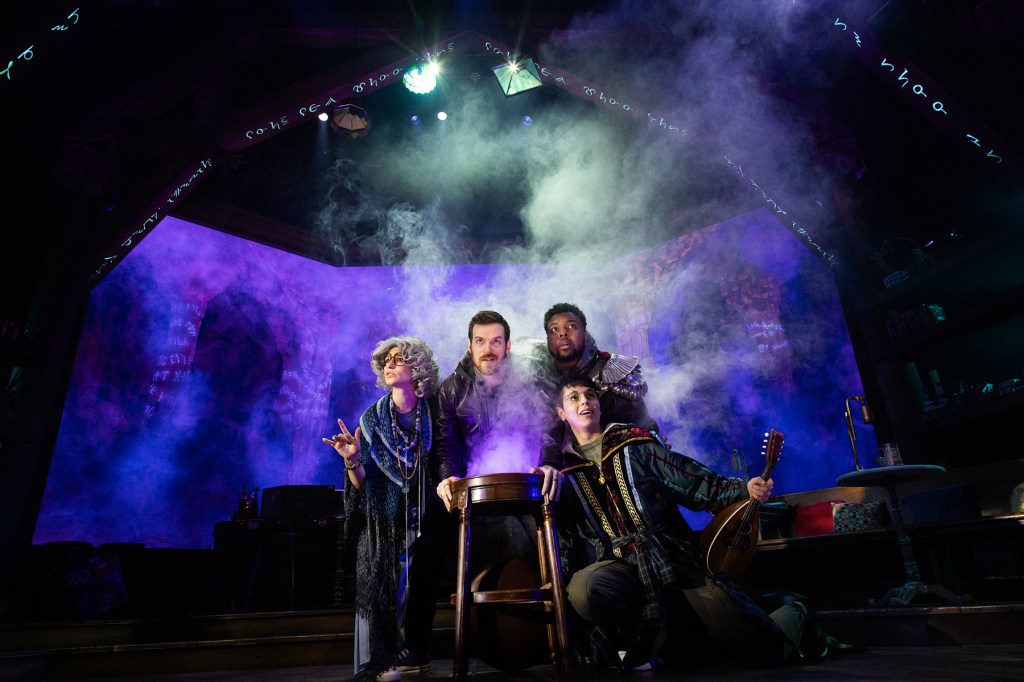Dice Rolls, Flow Charts, and an Undead Cowboy: Inside Off-Broadway’s Fun New Take on ‘D&D’
Before the backdrop of a magmatic cavern stand three adventurers: a warrior, a mage, and a trickster who, with a roll of the dice, are preparing to defeat a tentacled chthonic beast. Across the stage, the Dungeon Master smirks as he cues up the visuals that will soon appear on the massive LED screen behind him. The roll is a success, leading to the question every Dungeons & Dragons player longs to hear:
“How do you want to do this?”
Sarah David Reynolds as the Tavern Keeper; (R) DAGL as the Dungeon Master
Bronwen Sharp
The crowd roars in the off-Broadway theater as the trickster plays out the killing blow, describing his actions in detail before the flickering stage lights and booming sound effects accompanying his attack take over. It’s another thrilling end to a night at The Twenty-Sided Tavern, the improv comedy show-meet-tabletop gaming experience that recently began its run in New York City and nobody had any clue how it would play out — not even the actors themselves.
In basic terms, The Twenty-Sided Tavern is a live tabletop-game session that takes a streamlined approach to a Dungeons & Dragons campaign, and is the first theatrical production officially sanctioned by Hasbro’s Wizards of the Coast, which owns the rights to D&D. With a cast of actors making up the party, led by a Dungeon Master as emcee and Tavern Keeper as his sidekick, it’s a show that weaves the unpredictability of improv and the game itself into a feat of controlled chaos.
At frequent intervals in the show, the audience is asked to use a web-based app to make decisions that impact the on-stage antics. With short prompts, they’ll decide which characters the actors will portray, make decisions about their actions, and solve puzzles that will determine the outcome of a scene. There are even physical challenges where select attendees come directly on stage to throw darts, play beer pong, or play the role of a character in certain scenarios.
Does this sound like a nightmare? Maybe. The idea of an audience-driven, interactive stage show that piggybacks on tabletop gaming really shouldn’t work, at least not without being cheesy. And it is cheesy, but that’s part of the show’s earnest charm which, combined with surprisingly deep layers of technical storytelling, manages to engage even those who’d never dreamt of picking up fantasy roleplay. Although developed by tabletop players, it’s intended for gamers and non-gamers alike.
“I’m a big gamer,” says co-creator and tech designer David Carpenter. “I love the fact that we can all get in a room and play games together, and it can be a show that is participatory — but truthfully, It’s authentic. The audience is making the choice and [we want] them to feel that everything we’re doing is truthful.”

(Left to right) Madelyn Murphy, DAGL, Tyler Nowell Felix, and Diego F. Salinas
Bronwen Sharp
With all the variables, it would’ve been easy to keep the bulk of the show scripted, and it is to a degree, with the major plot points mapped out. But the reality is very complex. Behind the tavern’s bar lies a script monitor with pages of potential beats to follow, but most of it won’t be used in a show; it’s merely there as a guide. Another monitor shows the sequence chart, a branching list of possible scenarios that can play out dependent on each decision or dice roll. What begins with a simple flowchart rapidly expands as the game progresses, becoming a dizzying web of hundreds of potential outcomes for the narrative. It can even end with the characters’ deaths, but there are contingencies for that, too.
And while it would’ve been easier to fake the open-endedness of the plot to keep things more manageable, it wouldn’t have been true to the ethos of D&D: player choice.
That element means that audiences can see the show multiple times and never have the same experience. From the onset, they’re given the choice of which character each player will embody from a shortlist pulled from 33 total characters designed for the show. In the show I attended, players opted for a comedic trio of a dwarven supervillain, an undead cowboy, and a warrior who’s actually two kids in a trench coat. Clearly, standard fantasy fare.
Despite the level of audience choice, there’s still a ton of heavy lifting done by the actors, who not only have to improvise their scenes, but are actually playing the game (yes, the dice rolls are real). They also need to be, you know, funny. Even with the legitimate chops of a D&D campaign behind it, a show like Twenty-Sided Tavern lives and dies on whether its cast can sell the ridiculousness of the premise while keeping the crowd laughing. Comedic talent is the key to casting. Proficiency at Dungeons & Dragons, less so.

Diego as The Trickster discovering which character the audience has chosen for him
Bronwen Sharp
“The three things that we tell [actors] are: They need to be funny, they need to be good storytellers, and they need to be good at D&D – in that order,” says writer and Dungeon Master David Andrew Greener Laws, who goes by DAGL. “We can teach people how to play D&D, you can’t teach people how to be funny.
The improv element works to the show’s benefit and detriment, but even the “detrimental” effects have the potential to make good comedy. In our show, the audience members opted to name multiple NPCs “Kate.” With numerous imaginary characters with the same name, marked only “Kate 1” or “Kate-Too,” it was up to DAGL to embody both characters, sometimes in conversation between them, leaving the DM and the players themselves frequently confused or playfully flustered. But it quickly became a running gag for the actors to play off.
And if the notion of making up a show based on audience shout-outs and dice rolls seems tough, imagine doing it all while directing, too. The game’s scenarios are depicted on a massive LED wall at the rear of the stage, changing dynamically with hit point meters and visualizations of the combat effects onscreen, all manually controlled in real-time by the Dungeon Master and Tavern Keeper. Working in tandem to keep both the gameplay and the technical aspects of the show on the rails, the frenzy of their overlapping roles adds a precariousness to the house of cards vibe of the show. Yet they remain undeterred.
“It’s what every DM dreams of,” says DAGL. “[To] have access to sound, lights, smells, and props.”
Like the best games of D&D, The Twenty-Sided Tavern is at its peak when it seems to be going to shit, only for the makeshift plan to tie it all together in the end.
“The tabletop players know,” says writer and game designer, Sarah Davis Reynolds. “We could try to fake it — come up with a story. The dice have a better idea.”





